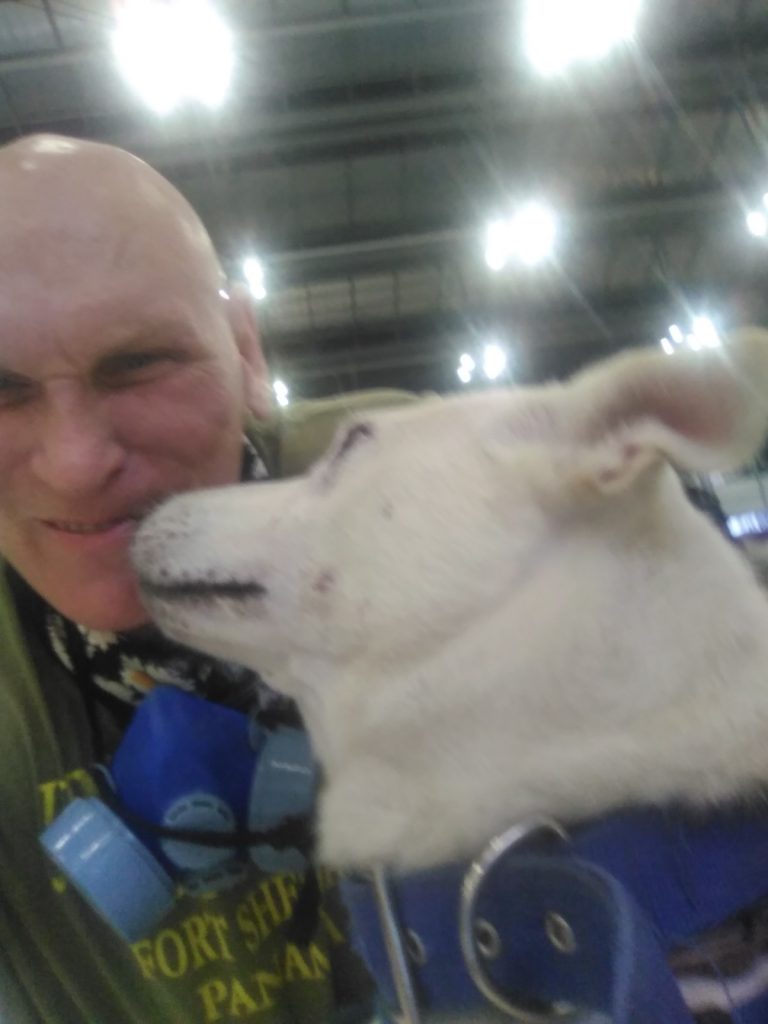
Photo of Rex the Jungle Pariah Dog and C. Clugston at the Bangkok Airport
ABOUT THE TRAINER
Christophe Clugston, B.S., B.A.ed., M.A. trained his first competitive obedience dog in 1974. During this time he was mentored by arguably the most influential and renown dog trainer in the USA W. K. (on the far right in the photo below).

ACADEMIC ANIMAL TRAINING
To increase his Animal Training Skill Set he obtained a Bachelor of Science degree in Psychology that included advanced Respondent/Operant Conditioning (Behaviorism) courses. These courses required that he demonstrate real world skills via training rats in very complex behaviors (e.g., placing a specific colored marble into a hole in a specific can as part of a very long behavior chain). Additionally, he also trained several domestic cats to perform tricks.
An example of Operant Conditioning: Behaviorism
Back to canines,
Clugston worked with notoriously difficult to train dogs: arctic breeds, sight hounds primitive breeds, and pariah/village dogs. Known for their intellect, independence and non submissive behavior they are vastly different than what most people have as Pet Dogs.

A THREE CONTINENT TRAINER
His training experience includes dogs on 3 continents–from training family dogs in functional skills to training War Dogs in various tactical skills and, of course, creating a DEEP BOND with Pariah and Village Dogs.

This diversity of training covered such skills as Precision Obedience, Advanced Obedience, eclectic mixture of Agility & Freestyle skills, hunting dog skills, sled dog skills, protection skills (with consultation to IGP practitioners), hunting dog tracking skills, and unique tactical mission skills.

ABOUT THE MERGE METHOD
The first step is to establish the most effective and efficient communication between you and your dog. In short the Merge Method is a combination of Movie Dog Training Secrets and the Science of Elite Working Dog Training,
One way we accomplish this is through Signal Speak Alpha and Signal Speak Bravo, science applied to insure the clearest delivery of information Human to Canine.
This encompasses some facts that you might not be aware of.
One, there is no language between humans and canines. This is an empirical reality for a number of reasons–humans use language which means that same language humans speakers (e.g., English speakers) can have two way conversations creating and understanding NEW verbal constructions and new vocabulary.
To illustrate a part of this the problem: English speakers use a huge number of phrasal verbs (get down, get back, sit down, go back, lay down, go home, go away, go to, leave it, leave off, etc.) the only reason that native English speakers make any semantic sense of these is because of frequency and the linguistic community they were reared in. Situations are paired with the phrases over and over from childhood through adulthood. (This is Respondent Conditioning)
These phrasal verbs are so culturally specific that it’s quite easy to see how confused second language English speakers become while trying to learn them by observing second language learners in various classrooms around the World. So, if it’s difficult for humans to understand these peculiar language community practices –it’s literally IMPOSSIBLE for canines to even attempt to understand them.
FACT: Canines don’t use a language they use a SIGNAL SYSTEM.
And Humans use signals everyday–what’s a Traffic Light? It’s a signal system that gives you information you react to it, but you aren’t holding a conversation with a traffic light and it doesn’t matter what you say to it.
It’s important that you realize and deeply understand that canines speak and understand NO human language: NOT Russian, NOT French, NOT English, NOT Spanish, NOT Icelandic, NOT any human language..

Here’s something that will shake you up…
It’s quite easy for me to throw all of you native English speaking humans for a loop by simply changing the verbal phrase syntax.
For example, if I tell you down sit, back go, it leave, around go, up back, down lay, etc. you will cognitively freeze and be incapable of doing the actions. Think about it–if a human with a very large frontal cortex and an innate language skill freezes up and doesn’t comprehend novel verbal utterances, what can you expect from a canine?
Therefore, doesn’t it benefit us to be extremely clear via VERBAL SIGNALS?
This clarity is exactly why I use Signal Speak Alpha the prime way in which canines understand and learn combined with Signal Speak Bravo, a proprietary phonetically and phonotactically engineered verbal system. I’m aiming for the clearest signal transmission and reception (more about that later).
Fact Two, canines are genetically more attuned to NONVERBAL SIGNALS than to verbal signals. Canines demonstrate their intentions, desires and emotional states to other canines via NON VERBAL SIGNALS (more about this in my video further down).
.

Ancient man (far before humans tried to use language with canines) were aware that body movements: body positions, shoulder movements, arm and hand movements were quickly processed as a SALIENT SIGNAL to canines.
It is for this very reason that you will find NON VERBAL SIGNALS being used by handlers and trainers of Sheep Herding Dogs, Cattle Herding Dogs, Seeing Eye Dogs, Police and Military Dogs.
Using the power of synergism via the most productive scientific learning/teaching methods for canines can be greatly accelerated when there is a DEEP BOND between human and canine.
For the humans this is achieved by understanding all facets of the dog (your dog). And it includes knowledge of the dog’s evolution. Warning, no matter how some high profile celebs want to compare dogs to wolves–they are not.

The DNA difference between wolves and dogs is roughly the same difference between chimpanzees and humans.
First and Foremost I’m concerned about the welfare of the dog and my method reflects that.
Deep Dog Bond Method comprehensively creates an effective bond with your dog.
It creates this via a comprehensive understanding of the human/canine relationship.
His greatest contribution to canine training is the revolutionary development of signal vs. language clarity. It’s important to understand that canines do NOT use a language with other canines. They use a series of SIGNALS.
Trying to project human language (especially if you’re a monolingual with no analysis of linguistics) is putting a great obstacle to effectively giving information to your do
Recent Comments